The Forgotten War
Published in 20th-century / Contemporary History, Features, Issue 3 (Autumn 2000), Volume 8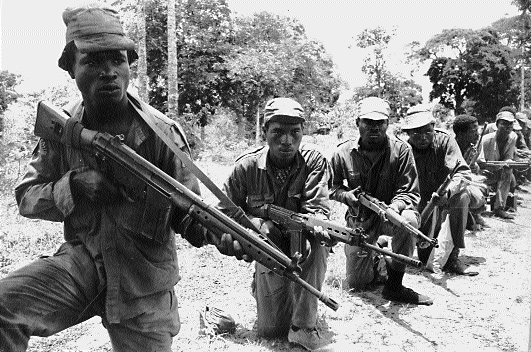
Biafran troops prepare for attack on the Awka front, April 1968. (Holy Ghost Fathers)
That last January saw the thirtieth anniversary of the end of an African civil war and that this moment passed without comment in Ireland seems at first glance an unremarkable statement. But this was no run-of-the-mill conflict on a continent which has endured more than its share of such tragedies. The war which erupted in Nigeria in 1967, when its eastern region seceded, was to resonate across the world producing an emotional outpouring in Ireland unequalled by the response to any foreign civil conflict between that of Spain in the 1930s and Yugoslavia in our own time.
Irish religious empire
If Ireland’s overseas missions can be spoken of as a ‘religious empire’ then Nigeria was the jewel in the crown. At a time when one in every 120 Irish adults worked abroad in a missionary capacity their greatest concentration was to be found in that country. The Irish influence ran through every level of the church. Of its three archbishops, one of them, McCarthy, of the northern Kaduna diocese was Irish as were the secretaries of the other two. The episcopal see of Owerri was held by the County Limerick-born Joseph Whelan, that of the western diocese of Iabadan by a native of Mayo, Richard Finn. The bishoprics of llorin, Ogoga, Ogo, Olo Kaduna, Benin and Calabar were all occupied by Irishmen often with lrish secretaries; over 500 at the country’s 800 priests were Irish; Irish church personnel ran 2,419 primary schools catering for 561,318 pupils, twice as many as in the rest of Africa combined. The forty-seven religious-run hospitals serving 714,441 patients equalled the corresponding figure for the remainder of the continent. With such a service network, as vast as it was unique, lreland’s only African embassy was, not surprisingly, in Lagos.
The territory of Nigeria had been acquired piecemeal by Britain over the nineteenth century, united in 1914 when its northern and southern protectorates were amalgamated. It became a federation in 1954, achieved full independence within the Commonwealth in 1960 and was declared a federal republic in 1963. lts fifty-five million people comprised over 200 racial groups with three principal ones. In the north the mainly Muslin Hausa/Fulani people inhabitant the country’s least developed region, its days as the hub of a once great empire now a distant memory. In the west are found the Christian and animist Yorubas, the most urbanised, due to their longer contact with Europeans, extending back to the Portuguese slave trade of the fifteenth century. And in the east the Igbos are dominant, the people whose story is as central to the history of modern Nigeria as it is to the tragic events leading to civil war.
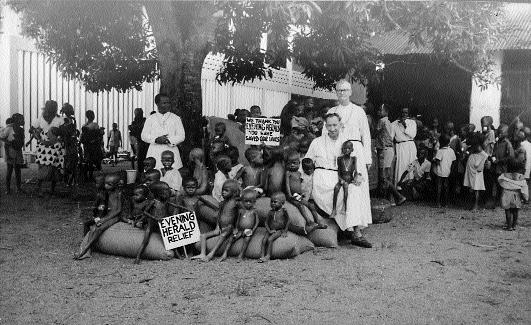
September 1968-the Evening Herald organised its own appeal and, in conjunction with UNICEF, raised £56,000. (Holy Ghost Fathers)
Seen as a less advanced tribe by nineteenth-century British colonialists, their ready adaptation to European ways had taken them to a pre-eminence first over the smaller tribes of the East and than within the country as a whole, becoming key players in trade and administration and controlling the upper echelons of the army.
Igbos: ‘black Jews of Africa’
The resentment against these ‘black Jews of Africa’ as upstarts was perceived most strongly in the semi-feudal north. Igbos lived in separate quarters at Kano and other Northern towns. The discovery of oil in the eastern region (in the territory of the smaller tribes) enhanced their economic superiority. These years had seen the country’s politics riven along ethnic lines largely corresponding to the triangular tribal division described. In January 1966 a section of the Igbo-dominated officer corps staged a bloody and unsuccessful coup whose victims included the premiers of the northern and western regions. Despite its failure the new ‘compromise’ regime was headed by an Igbo, General Ironsi, but by its corruption, authoritarianism and centralising tendencies it lost any chance of conciliating Yoruba disaffection ensuring that in any conflict which occurred the divide would not be along the traditional north/south fault line but would see the east pitted against the rest of Nigeria. And the split was not long in coming.
In July 1966 another coup by non-Igbo army officers (the army’s junior ranks were staffed by members of the smaller tribes of central Nigeria) resulted in the death of Ironsi and the accession to power of General Yakubu Gowon. Two months after, following reports of attacks on northerners living in the east, violence flared across northern Nigeria involving wholesale slaughter of Igbos. Whatever the true death toll—estimates range from the low thousands to the tens of thousands—in the eyes of the survivors it was an act of genocide. Up to a million Igbos fled to the security of the east bringing with them horrific stories of murder and destruction. The countdown to secession had begun.
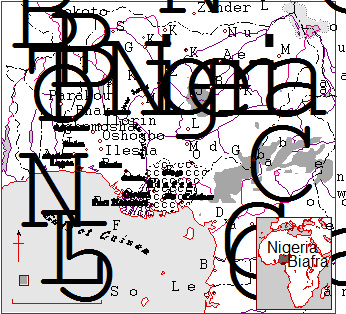
When secession finally came on 30 May 1967 not all the inhabitants of the former Eastern Region were loyal citizens of the newly-proclaimed Biafra. Gowon’s concession of autonomy to the smaller tribes had seen to that. The outbreak of the thirty-month war in July 1967 took most observers by surprise as the rebel army seized the initiative with a lightning thrust which took them to within 135 miles of Lagos. But after being halted in August the offensive lost momentum.
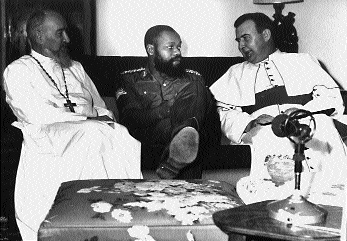
Bishop Conway of Elfin (right) in conversation with Biafran leader Colonel Eni Njoku. (Holy Ghost Fathers)
The new year saw federal forces across Nigeria closing in on the Igbo heartland. After the fall of Port Harcourt in May 1968, Biafra, now land-locked, faced a food and refugee crisis on its largely infertile soil. Famine conditions resulted, electrifying world opinion until the collapse of the revolt in January 1970.
Irish government policy under pressure
From the outset the approach of the Dublin government and its Lagos embassy was to uphold Irish missionary interests in the country. As only 700 of the 2,500 church personnel resided in the eastern region it was essential that nothing be done to antagonise the authorities in the rest of the country. In what was to be the mainstay of Irish government policy throughout, a circular to all its embassies rejected recognition of Biafra, reaffirmed Ireland’s support for Nigeria’s territorial integrity and ruled out mediation, stressing the internal nature of the dispute. It was not long before pressure emerged from several quarters to change this course. In the Dáil it came from the Fine Gael and Labour opposition, some even supporting recognition of Biafra. Outside it came from Independent Newspapers, with their relief fund and highly emotive coverage of federal army actions and a general pro-Biafra bias. It came from across the Atlantic, from the US State Department in an attempt to get greater Irish involvement. In addition the government had to withstand a vigourous lobbying effort by Biafran representatives based in London and later in Dublin itself. But the biggest challenge came from activities on the ground in Ireland.
Early in 1968 as a result of a newspaper appeal by Vincent Grogan, Supreme Knight of the Knights at Columbanus, the interdenominational Nigeria/Biafra appeal was launched. In tandem came the formation of the Africa Concern organisation (later to become the world-famous charity Concern), registered as a limited company in July 1968. The previous month, at the Knights’ headquarters, Ely House, Bishop Whelan of Owerri, the diocese covering the Igbo heartland, had been the guest of honour at the launch of the joint Biafra famine appeal in which the two organisations came together. Catholic church personnel, particularly from Whelan’s Holy Ghost Fathers, were prominent in each. And despite the humanitarian thrust of the campaign there was no mistaking the undertones of disapproval for Irish government policy. The evening before the launch, at a meeting of the Supreme Council of the Knights, with Bishop Whelan in attendance, Vincent Grogan had criticised the government approach.
Huge public response
Strongly supported by Independent Newspapers (the Evening Herald even organised its own appeal), and coming at a time when memories of the Great Famine were revived in the public mind (the 120th anniversary of Black ‘47 had just passed and Cecil Woodham Smith’s book on the subject was still a best-seller), and with the victims’ plight coming nightly into living rooms through the new medium of television, the collections took the country by storm. Within a fortnight £10,000 had been collected, within a month almost £62,000. By mid August 1968 the figure had topped the £100,000 mark, climbing incrementally to £278,000 by February 1969. The Evening Herald, in conjunction with UNICEF, had raised £56,000 and an appeal by the Catholic hierarchy had brought in over £120,000. The government, whose relations with Africa Concern remained fraught throughout the conflict and for long after, donated £130,000 to the Red Cross, the only aid agency without a credibility problem in the eyes of the Nigerian government.
Allegations of gun running
Since the fall of Port Harcourt in May 1968 most of the aid reaching the blockaded enclave came by air, from the international Red Cross on the island of Fernando Po or Joint Church Aid (JCA) operating from the Sao Tome island further south. The French Red Cross ran an airlift from the Gabonese capital Libreville which Africa Concern joined, though it also flew material under the JCA umbrella. JCA was managed by the Catholic church Caritas agency under the overall direction of the Holy Ghost Fathers’ ‘Green Pimpernel’, Fr. Tony Byrne. As all but the International Red Cross flew without Nigerian permission and by night, and as Biafra continued to fight back vigourously, the Lagos government suspected arms smuggling and reacted accordingly. Flights to the makeshift runway ‘airstrip Annabelle’ a converted motorway at Uli, had to dodge nightly anti-aircraft fire once they reached the coast. In October 1968 controversy erupted in Ireland when the Nigerian Commissioner for Home Affairs, Chief Anthony Enahoro, was quoted as having said, after a meeting with external affairs minister Frank Aiken, that the latter had confirmed the involvement of named Holy Ghost Fathers in gun running.
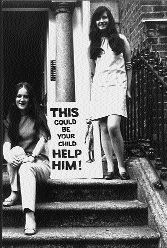
The collections for Biafran relief took Ireland by storm. (Holy Ghost Fathers)
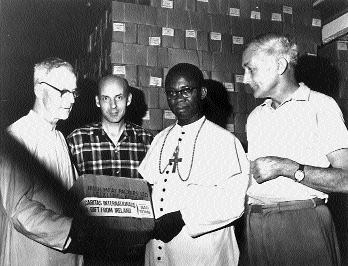
Limerick-born Bishop Joseph Whelan of Owerri (left) accepts Caritas aid flown in from Sao Tomé. The Nigerian federal government claimed that aid flights were a cover for gun running. (Independent Newspapers)
Though official channels dampened it down, the affair revealed considerable hostility by Enahoro towards the order, whose members he described as ‘indistinguishable from rebel supporters’. In mitigation Aiken had pointed to their long work with the Igbos but blamed that tribe for fomenting the conflict and stressed Ireland’s determination that boundaries would not be changed by force ‘lest Africa be compelled to endure the experience of Europe throughout the centuries’. Enahoro had thanked him for this support conveying General Gowon’s gratitude to some Irish men, in particular Professor Robert Collis, a paediatrician resident there since 1957. Aiken subsequently persuaded Collis (who later achieved celebrity status as Christy Brown’s doctor) to write a series of pro-federal articles for the Irish Times. The allegations of gun running persisted despite the objections by Irish officials to the Nigerian naming of supposed culprits and the strenuous denial by Fr. Tony Byrne on the Late Late Show in January 1969.
Behind the scenes the Irish government was under no illusions about their countrymen’s involvement. In December 1969 a secret memorandum from the Department of External Affairs to the Department of Transport and Power reported a plane chartered for gun running purposes in Lisbon and warning of the direst consequences for Ireland’s image if such information became public knowledge.
Friction continued between the government and Africa Concern. At the meeting with Enahoro Aiken admitted that its existence ‘presented difficulties’. In November 1968 the Irish ambassador in Lagos, Paul Keating, confessed himself reluctant to meet Vincent Grogan lest he be seen to give the group ‘an official blessing’. The following autumn, John O’Loughlin Kennedy, its managing director, ran into opposition when he sought government support for the refitting of the food ship Columcile, temporarily leased by Africa Concern to the Red Cross. Keating, though he professed admiration for the selflessness of its personnel and disclaimed any hostility towards the organisation advised the government to proceed with caution. In support he cited not simply ‘rumours’ similar to those circulating about JCA and the Red Cross but ‘reliable reports from sources not hostile to them’ of their planes being used for the transport of munitions. In addition Africa Concern had ‘openly admitted’ in Irish newspapers to flying in fuel and foreign journalists, all of which the Lagos authorities viewed as acts of war. His ‘extreme worry’ on this point was, he said, strengthened by the fact that so many other aid organisations, JCA, UNICEF and the Red Cross, considered them unreliable also. As a compromise the government made £25,000 available to UNICEF if Africa Concern agreed to share the ship with it for a six month period. So great was the hostility towards this organisation that when the famine relief body Gorta was formed in Dublin, Keating in Lagos, detecting ‘a whiff of Africa Concern about it’, wrote to the department demanding a curb on its activities. The line did not change as memories of the conflict receded and personnel changed. In May 1971, a year and a half after the Biafran surrender, the organisation again drew the government’s fire. A fund-raising advertisement in Irish newspapers depicting a Biafran child with a Kwashiorkor distended stomach brought protests from the Nigeria embassy. Following the intervention of Keating’s successor in Lagos, Tadhg O’Sullivan, who condemned it as obscene, the advertisement was withdrawn.
Dilemma for the Catholic Church
The attitude of the Irish government becomes easier to understand when one considers two factors: the position of the Catholic church in Nigeria and the international situation. When the war began Catholics were concentrated in the breakaway region. The civil war presented the church with a dilemma. To remain neutral could be seen as an abandonment of the Catholic Igbos, yet to take their side could marginalise the church within an overwhelmingly non-Christian country. Orders like the Holy Ghost Fathers and Holy Rosary Sisters were predominantly eastern-based yet others like the SMA were active largely outside of it in the church’s real mission territory. From the beginning of the conflict pro-Biafran propagandists stressed the theme of religious persecution, a point just as vigourously denied by their opponents who pointed to the Christian majority both within the federal army and cabinet, including Gowon himself. Archbishop Aggey of Lagos, a Yoruba, complained to Ambassador Keating of Pope Paul VI’s criticism of federal forces, which Aggey had pleaded with the Pope not to make. In the company of Bishop Finn, who condemned the pope’s remarks as ‘ill advised’ and ‘influenced by pro-Biafran groups’, he had visited Gowon afterwards to explain the situation. These actions stemmed not from a blindly pro-federal position—Finn had, for instance, sheltered the Biafran leader Eni Njoku during the pogroms before the war—as from a perception of what the alternative might mean for the church. Even Archbishop McCarthy, a pronounced pro-federalist, had saved the life of major general Philip Effiong, Biafra’s chief-of-staff, during the 1966 massacres, later smuggling him to safety in the east.
The cumulative effect of the Vatican interventions was to provoke demands for the ‘Nigeranisation’ of the church. With the fall of the enclave both this demand and the demand for the expulsion of the eastern missionaries began to be fulfilled. Over a hundred church personnel were served with deportation orders, including Bishop Whelan who arrived to a hero’s welcome at Dublin airport attended by representatives of all political parties. Before he left Nigeria, Bishop Whelan had admitted many of the church’s faults to Lt. Col Diete Spieff, the new federal military governor of the Rivers Region, a young Catholic from a minor tribe in the area. The Igbos, Whelan told him, had become too dominant a people and their downfall was attributable to that fact. A possibility now existed for rebuilding the church on the territory of the smaller tribes like the Ogoni and Calabari who have suffered under Igbo hegemony. Such a church would have to be a Nigerian one to survive.
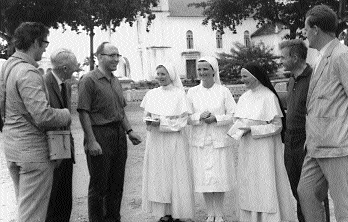
Holy Ghost Fathers’ ‘Green Pimpernel’, Fr. Tony Byrne (third from left), in Sí£o Tomé with members of the Evening Herald medical team. (Independent Newspapers)
As things stood there was only one Rivers priest among the clergy of the entire area. Similar sentiments had been expressed by others including Bishop Finn who predicted that within a decade their would be ‘little or no room’ in the western region either for foreign clergy or missionaries. Finn had earlier written to his brother Martin, a Fine Gael TD, asking him to exert a discreet influence to counteract any official tendency towards lionising those expelled. In a similar vein the provincial superior of his SMA order, Laurence Carr, had written to the minister congratulating the Dublin government for its ‘one Nigeria’ policy throughout.
International situation
The international situation took shape in a manner unusual for the Cold War. With the Organisation for African Unity (OAU) and the Soviet bloc all supporting Nigeria, any attempt by the United States and its allies to fight a proxy war through Biafra was stymied, the race issue saw to that. Of the five states recognising Biafra all but one (Haiti) were African. No country with Ireland’s proud anti-colonial past could join the ranks of Biafra’s unofficial white backers, ranging from France to Israel, and including clerical/fascist Portugal and the racist regimes of Rhodesia and South Africa. The ‘principle of self determination’, so loudly trumpeted in Biafra’s favour, had never overridden the integrity of a state since the UN was formed. Of the exceptions, Bangladesh in 1971 involved a country separated from Pakistan by thousands of miles of Indian territory, and the recent dismemberment of Yugoslavia reflected not a changed legal position but the double standards of a new world order marked by American and German dominance.
Amnesia
Bishop Finn had predicted to his brother that time would prove the best healer. He was right. Biafra swiftly disappeared down the memory hole helped by a wish to let bygones be bygones. When in 1974 a play on the subject, Black Man’s Country, by Holy Ghost Father Desmond Forristal premiered at the Gate Theatre, protests came from other religious who disputed its accuracy or appropriateness. By the end of the decade a standard Leaving Certificate history text (Kenneth Neill, Our Changing Times) defined the conflict, incorrectly, as one merely between Igbos and Yorubas. In the following decades it vanished off the screen entirely as a more secular Ireland emerged; the recent Irish Times Book of the Century failed even to accord it a mention.
But the amnesia does not work both ways. Memories of Ireland’s apostolic mission ensure that Nigerians are now arguably the largest group of asylum seekers in the country. In a diatribe against them recently in a provincial newspaper a columnist claimed that ‘this country has no direct links with Nigeria’ (‘J.M.’s Plain Chant’, Western People, 11 May 2000). Nothing could better exemplify the oblivion which has overtaken the bond with ‘Ireland’s African twin’, a bond which made that country’s thirty-month war one of the most emotive causes in the history of this state.
Enda Staunton is an external tutor at Knightsbridge University and researcher with the (Northern Ireland) Standing Advisory Commission on Human Rights.
Further reading:
J. De St Jorré, The Nigerian Civil War (London & Boston 1972).
E. Staunton, ‘The Case of Biafra: Ireland and the Nigerian Civil War’ in Irish Historical Studies, Vol. XXXL, No. 124. (Nov. 1999).
















